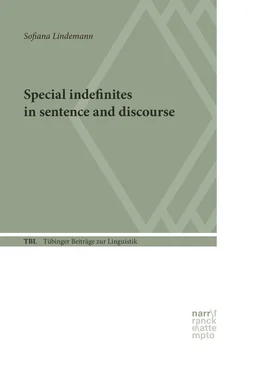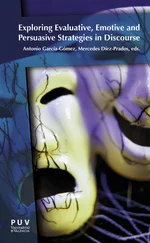Despite their preference for particular referential readings, the distinction between a specific and a non-specific reading of the two types of indefinite noun phrases in German and Romanian is not that straightforward as it might seem at first sight, though. Consider example (6), in which both the indefinite headed by so’n as well as the indefinite headed by einen (‘ a/an’ ) are compatible with a continuation sentence in which the identity of the referents they are associated with is denied. In other words, both indefinite noun phrases get a non-specific reading.
| (6) |
Maria will so’nen/ einen Prinz auf einen weißen Ross heiraten. Aber sie hat noch keinen kennengelernt. |
|
Mary wants to marry so-a/ a prince on a white horse. But she has not met one yet.’ |
In this book I argue that the tendency for particular referential readings (i.e. wide scope, fixed reference, epistemic specificity, etc.) stems from the speaker’s referential intention to introduce a referent that will give structure to the discourse in terms of referential persistence or continuation and potential topic shift.
To investigate the discourse structuring potential of indefinite noun phrases in English, German and Romanian, I analyse production and comprehension biases while referring. To this end, I restrict the experimental studies by (i) using a constrained form of discourse, i.e. multi-sentence discourses and by (ii) focussing on the establishment of referential chains. The dependent variable is the way writers refer subsequently to the referents introduced in the initial stories. For a brief illustration, consider the two mini-discourses given in Table 1.1, which are taken from the story continuation experiment reported in Chapter 5.
|
pe -marked direct object |
non- pe -marked direct object |
| S0 |
Anul trecut când am fost la mare am cunoscut un salvamar 1. (Pro) 1era tot timpul activ. La sfârşitul sejurului meu, ( pro) 1a salvat- o pe o fată 2de la înec. ‘Last year when I was at the seaside I met a lifeguard 1. He 1was very active all day long. At the end of my stay there, he 1saved PE-a girl 2from drowning.’ |
Anul trecut când am fost la mare am cunoscut un salvamar 1. (Pro) 1era tot timpul activ. La sfârşitul sejurului meu, ( pro) 1a salvat o fată 2de la înec. ‘Last year when I was at the seaside I met a lifeguard1. He 1was very active all day long. At the end of my stay there, he 1saved a girl 2from drowning.’ |
| S1 |
M-a mirat că (pro) 1a reușit să o 2salveze, pentru că (pro) 1era un burtos. ‘I was surprised that he 1could save her 2, because he 1was a big-bellied man.’ |
(pro) 1Era un tip solid, mustăcios și încrezut. ‘He 1was a strong man, moustachioed and conceited.’ |
| S2 |
Dar cum (pro) 1a văzut- o pe fată 2că ( pro) 2striga după ajutor, (pro) 1nu a stat pe gânduri și (pro) 1s-a dus după ea 2. ‘But as soon as he 1saw PE-girl 2that she 2was screaming for help, he 1did not hesitate and went after her 2.’ |
Deși (pro) 1era enervant, multe fete îl 1plăceau. ‘Despite the fact that he 1was annoying, many girls liked him 1.’ |
| S3 |
Fata 2era inconștientă când ( pro) 2a fost adusă la ţărm. ‘ The girl 2was unconscious as she 2was brought to shore.’ |
După ce (pro) 1a salvat- o pe fată 2de la înec, (pro) 1a devenit atracția plăjii. ‘After (pro) 1saved PE girl 2from drowning, (pro) 1became the attraction of the beach.’ |
| S4 |
( pro) 2nu avea mai mult de 10 ani. ‘ She 2was not older than 10.’ |
Toată lumea vroia să se fotografieze cu acest bărbat curajos 1. ‘Everyone wanted to be photographed with this brave man 1.’ |
Table 1.1:
Sample experimental item from the experiment on pe -marking (Chapter 5)
Note that the indefinite noun phrases realized in direct object position in the initial context (i.e. S0) constitute minimal pairs, in the sense that the descriptive material of the noun phrases and the verbs selecting these objects are almost the same. I only manipulated the type of indefinite noun phrases used in direct object position in the two contexts (i.e. a pe -marked direct object in the left column vs. a non- pe -marked direct object in the right column of Table 1.1). The two direct objects in Table 1.1 differ with respect to their discourse structuring potential, which becomes evident in the continuation sentences. The referent of the direct object preceded by pe is introduced in sequence S0 by means of the indefinite noun phrase pe o fată (‘PE a girl’). Within the next sentences – (S1) through (S4) – the referent of the indefinite noun phrase is mentioned again six times. On the contrary, the referent of the non- pe -marked direct object o fată (‘a girl’) is mentioned in the discourse following its first mention in S0 only once, in continuation sentence three (i.e. S3). Based on larger discourse contexts like the ones illustrated in Table 1.1, I show that the functions of the three indefinite markers ( this, so’n and pe ) discussed in the beginning of this Section are best accounted for in terms of their discourse structuring potential. The basic claims I wish to make are outlined in the following Section.
1.2 Goals of the book and proposed analysis
The main goal of this book is to account for the distribution of the three types of indefinite noun phrases introduced in the previous Section. I argue that English indefinite this , German so’n and Romanian pe -marking share several common characteristics at the semantic and discourse-pragmatic level, which distinguish them from noun phrases headed by the simple indefinite article a/an . First, at the semantic level, the three types of indefinites show a strong and robust affinity for particular referential properties (i.e. fixed reference, wide scope, epistemic specificity). Second, I suggest that any account of indefinite noun phrases that investigates only their sentence-level properties fails to capture their discourse-pragmatic contribution. By analysing larger discourse units (i.e. containing more than two adjacent sentences) in which such indefinite noun phrases occur, I show that compared to their simple indefinite correlates, referents associated with indefinite this in English, indefinite so’n in German and pe -marked indefinites in Romanian are more prone to: (i) be frequently mentioned in the ensuing discourse and to (ii) shift the discourse topic. At first sight, these two discourse effects call for an analysis in terms of accessibility or prominence. Most interestingly, however, the above-mentioned effects appear with a latency of one or two subsequent sentences after the indefinites were mentioned for the first time, in multi-sentence discourses. Furthermore, another argument that cannot be easily accommodated within exsiting models based on accessibility or prominence is the observation that referents introduced in this way show low rates of subsequent pronominalization. Despite being frequently rementioned and showing a high potential to become the topic, referents associated with these expressions are picked up by more lexial material (e.g. definite noun phrases) in the ensuing discourse. Rather than reflecting prominence, I propose that the special indefinite noun phrases function as discourse structuring devices. They are used as higher-level cues and their main function is to establish coherence at a more global level, by pre-activating particular referents. The pre-activating function is a signal to the hearer that the referent introduced in this way will be mentioned next and will eventually become the sentence topic. The findings presented in Chapters 3-5 ask for a reevaluation of the notion of accessibility or prominence. It will become evident by the end of Chapter 5, that the attested discourse structuring effects cannot be explained in terms of accessibility alone. Furthermore, we will see that pronoun production biases and pronoun interpretation biases are not modulated by the same notion of accessibility or prominence, thus a stricter dissociation between production and interpretation preferences is needed.
Читать дальше












